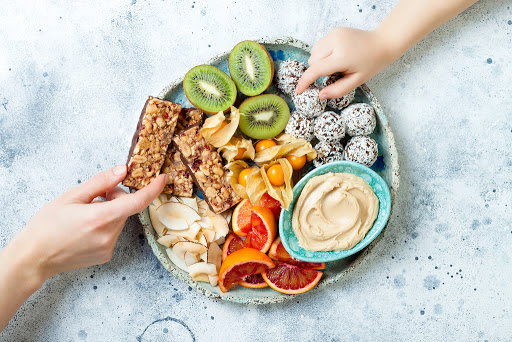Previous part – Rhythm Is The Key: Main Meals
Decreasing habits changing stress level is significant. When this happens – we always feel uncomfortable as it took ages to develop our old ones. This is why it is recommended to add our usual and most loved products to the day plan at least for the first few weeks. Let’s try to adjust the rhythm so that at any meal we are 100% responsible for the quality of the food.

Variety is the key basis of every diet. E.g.: porridge is not just a side dish. If your meal plan states: porridge + dill + olives + sesame or tahini + vegetable – try adding as many of these ingredients as possible.
Eat colorful and simply cooked meals improved by herbs, seeds and nuts. Enjoy your meals steadily, with no phone, laptop, TV or movie on. Focus on the food itself. What is it like: crunchy, soft, spicy, tender? This is how we control both: the amount of food and saliva enzymes, which are highly important for the absorption of nutrients. When we eat – our jaw, tongue and saliva work together. We won’t benefit even from the perfectly composed diet without proper fletcherizing.
If you abstain from some of the foods – choose anything else from the same group of products. Soups and cream-soups are optional, but that’s the perfect way to eat a lot of vegetables during 1 intake. It can be substituted by miso soup, which takes 5 minutes to cook (fermented soy + seaweed = gut health) or bone / tendon broth (not fillets).
Focus on products’ quality, especially when someone else is cooking for you.

It’s OK to have snacks, but they should be minimized. Make sure they happen less often and are not as hearty as your main meals. Breakfast, lunch and dinner are the basis. Priority snacks are fats and juicy fruits, berries, olives, a piece of cheese.
If you desire for a spontaneous snack or a meal after 9 p.m. – opt for olives, avocados, nuts, coconut yogurt or coconut milk tea, grain-free vegetable or nut crisps with caviar or salted fish.
A minimum break of 12 hours between dinner and breakfast is essential. 3 meals are enough during a day with pauses between them. Before getting another portion of food – ask yourself if you are actually hungry or is this just a habit of keeping your mouth busy or having a hearty dinner.
This is how we are fighting against premature aging and biological corrosion caused by free radicals caused by insulin resistance. What harms your membranas – harms your DNA and metabolism. This makes your body tissues degrade. What we can do is send signals to our body through food and a healthy lifestyle.
The most important signals are:
1) movement every day,
2) the quality and content of food with microelements in each meal and a 4-hour pause between the main large meals. 1-2 small snacks are still acceptable
3) time for rest and recovery at night – at least 12 hours without digestion,
4) fletcherizing (saliva enzymes) and fresh herbs, berries, vegetables daily (enzymes from fresh plant products),
5) good sleep.
The Final Part of a series – Rhythm Is The Key:5 Hallmarks


















